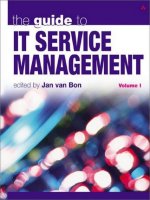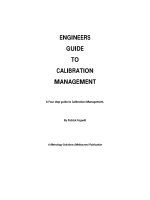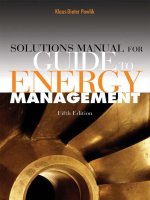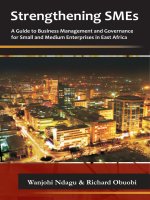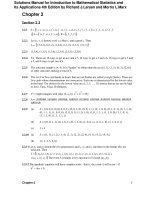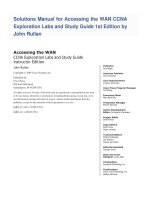Solutions manual for Guide to energy management
Bạn đang xem bản rút gọn của tài liệu. Xem và tải ngay bản đầy đủ của tài liệu tại đây (1.37 MB, 168 trang )
Solutions Manual
for
Guide to Energy Management,
Fifth Edition
i
This page intentionally left blank
ii
Solutions Manual
for
Guide to Energy Management,
Fifth Edition
Klaus-Dieter E. Pawlik
iii
Solutions manual for Guide to Energy Management, Fifth Edition
By Klaus-Dieter E. Pawlik
©2006 by The Fairmont Press. All rights reserved. No part of this
publication may be reproduced or transmitted in any form or by any
means, electronic or mechanical, including photocopy, recording, or
any information storage and retrieval system, without permission in
writing from the publisher.
Published by The Fairmont Press, Inc.
700 Indian Trail
Lilburn, GA 30047
tel: 770-925-9388; fax: 770-381-9865
Distributed by Taylor & Francis Ltd.
6000 Broken Sound Parkway NW, Suite 300
Boca Raton, FL 33487
tel: 800-272-7737; fax: 800-374-3401
Email:
Distributed by Taylor & Francis Ltd.
23-25 Blades Court
Deodar Road
London SW15 2NU
United Kingdom
Email:
Printed in the United States of America
10 9 8 7 6 5 4 3 2 1
ISBN 0-88173-497-7 (The Fairmont Press, Inc.)
ISBN 0-8493-3906-5 (Taylor & Francis Ltd.)
While every effort is made to provide dependable information, the publisher, authors,
and editors cannot be held responsible for any errors or omissions.
iv
Table of Contents
Chapter 1:
Introduction to Energy Management .................................. 1
Chapter 2:
The Energy Audit Process: An Overview ........................ 15
Chapter 3:
Understanding Energy Bill .................................................. 21
Chapter 4:
Economic Analysis and Life Cycle Costing ..................... 37
Chapter 5:
Lighting ................................................................................... 53
Chapter 6:
Heating, Ventilating, and Air Conditioning .................... 69
Chapter 7:
Combustion Processes and the
Use of Industrial Wastes ...................................................... 83
Chapter 8:
Steam Generation and Distribution................................. 103
Chapter 9:
Control Systems and Computers ......................................111
Chapter 10:
Maintenance ......................................................................... 119
Chapter 11:
Insulation .............................................................................. 127
Chapter 12:
Process Energy Management ............................................ 141
Chapter 13:
Renewable Energy Sources and Water ........................... 149
Management Supplemental ......................................................................... 159
v
This page intentionally left blank
vi
Introduction to Energy Management
1
Chapter 1
Introduction to Energy Management
Problem:
For your university or organization, list some energy management projects that might be good “first ones,” or early
selections.
Solution:
Early projects should have a rapid payback, a high probability of success, and few negative consequences (increasing/decreasing the air-conditioning/heat, or reducing
lighting levels).
Examples:
Switching to a more efficient light source (especially
in conditioned areas where one not only saves with
the reduced power consumption of the lamps but also
from reduced refrigeration or air-conditioning load).
Repairing steam leaks. Small steam leaks become large
leaks over time.
Insulating hot fluid pipes and tanks.
Install high efficiency motors.
And many more
1
2
Solutions Manual for Guide to Energy Management
Problem:
Again for your university or organization, assume you are
starting a program and are defining goals. What are some
potential first-year goals?
Solution:
Goals should be tough but achievable, measurable, and
specific.
Examples:
Total energy per unit of production will drop by 10
percent for the first and an additional 5 percent the
second.
Within 2 years all energy consumers of 5 million British
thermal units per hour (Btuh) or larger will be separately metered for monitoring purposes.
Each plant in the division will have an active energy
management program by the end of the first year.
All plants will have contingency plans for gas curtailments of varying duration by the end of the first
year.
All boilers of 50,000 lbm/hour or larger will be examined for waste heat recovery potential the first year.
Introduction to Energy Management
Problem:
3
Perform the following energy conversions and calculations:
a) A spherical balloon with a diameter of ten feet is filled
with natural gas. How much energy is contained in
that quantity of natural gas?
b) How many Btu are in 200 therms of natural gas? How
many Btu in 500 gallons of 92 fuel oil?
c)
An oil tanker is carrying 20,000 barrels of #2 fuel oil.
If each gallon of fuel oil will generate 550 kWh of
electric energy in a power plant, how many kWh can
be generated from the oil in the tanker?
d) How much coal is required at a power plant with a
heat rate of 10,000 Btu/kWh to run a 6 kW electric
resistance heater constantly for 1 week (16 8 hours)?
e) A large city has a population which is served by a
single electric utility which burns coal to generate
electrical energy. If there are 500,000 utility customers
using an average of 12,000 kWh per year, how many
tons of coal must be burned in the power plants if the
heat rate is 10,500 Btu/kWh?
f)
Consider an electric heater with a 4,500 watt heating
element. Assuming that the water heater is 98% efficient, how long will it take to heat 50 gallons of water
from 70 degree F to 140 degree F?
4
Solutions Manual for Guide to Energy Management
Solution:
a) V
=
=
4/3 (PI) P
4/3 × 3.14 × 53
523.33 ft3
E
=
=
=
V × 1,000 Btu/cubic foot of natural gas
523.33 ft3 X 1,000 Btu/ft3
523,333 Btu
b) E
E
=
=
=
200 therms × 100, 000 Btu/therm of natural gas
20,000,000 Btu
500 gallons × 140,000 Btu/gallon of #2 fuel oil
70,000,000 Btu
c) E
=
20,000 barrels × 42 gal./barrel × 550 kWh/gal.
4.6E+08 kWh
d) V
=
10,000 Btu/kWh × 6 kW × 168 h/25,000,000
Btu/ton coal
0.40 tons of coal
=
e) V
=
=
f) E
=
=
=
=
=
=
500,000 cus. × 12,000 kWh/cus. × 10,500
Btu/kWh × I ton/25,000,000 Btu
2,520,000 tons of coal
50 gal. × 8.34 lbm/gal. × (140F - 70F) ×
1 Btu/F/lbm
29,190 Btu
29,190 Btu/3,412 Btu/kWh
8.56 kWh
8.56 kWh/4.5 kW/0.98
1.94 h
Introduction to Energy Management
5
Problem:
If you were a member of the upper level management in
charge of implementing an energy management program
at your university or organization, what actions would you
take to reward participating individuals and to reinforce
commitment to energy management?
Solution:
The following actions should be taken to reward individuals and reinforce commitment to energy management:
Develop goals and a way of tracking their progress.
Develop an energy accounting system with a performance measure such as Btu/sq. ft or Btu/unit.
Assign energy costs to a cost center, profit center, an
investment center or some other department that has
an individual responsibility for cost or profit.
Reward (with a monetary bonus) all employees who
control cost or profit relative to the level of cost or
profit. At the risk of being repetitive, note that the level
of cost or profit should include energy costs.
6
Problem:
Solution:
Solutions Manual for Guide to Energy Management
A person takes a shower for ten minutes. The water flow
rate is three gallons per minute, the temperature of the
shower water is 110 degrees E Assuming that cold water
is at 65 degrees F, and that hot water from a 70% efficient
gas water heater is at 140 degrees F, how many cubic feet
of natural gas does it take to provide the hot water for the
shower?
E = 10 min × 3 gal./min × 8.34 lbm/gal ×
(110 F - 65 F) × 1 Btu/lbm/F
= 11,259 Btu
V = 11,259 Btu × 1 cubic foot/1,000 Btu/0.70
= 16.08 cubic feet of natural gas
Introduction to Energy Management
Problem:
Solution:
7
An office building uses 1 Million kWh of electric energy
and 3,000 gallons of #2 fuel oil per year. The building has
45,000 square feet of conditioned space. Determine the
Energy Use Index (EUI) and compare it to the average EUI
of an office building.
E(elect.) = 1,000,000 kWh/yr. × 3,412 Btu/kWh
= 3,412,000,000 Btu/yr.
E(#2 fuel) = 3,000 gal./yr. × 140,000 Btu/gal.
= 420,000,000 Btu/yr.
E = 3,832,000,000 Btu/yr.
EUI = 3,832,000,000 Btu/yr./45,000 sq. ft
= 85,156 Btu/sq. ft/yr. which is
less than the average office building
8
Solutions Manual for Guide to Energy Management
Problem:
The office building in Problem 1.6 pays $65,000 a year for
electric energy and $3,300 a year for fuel oil. Determine the
Energy Cost Index (ECI) for the building and compare it
to the ECI for an average building.
Solution:
ECI
= ($65,000 + $3,300)/45,000 sq. ft
= $1.52/sq. ft/yr.
which is greater than the average building
Introduction to Energy Management
Problem:
9
As a new energy manager, you have been asked to predict the energy consumption for electricity for next month
(February). Assuming consumption is dependent on units
produced, that 1,000 units will be produced in February,
and that the following data are representative, determine
your estimate for February.
—————————————————————
Given:
Month
Units Consumption Average
produced
(kWh)
(kWh/unit)
—————————————————————
January
February
March
April
May
June
July
August
September
October
November
December
January
Solution:
600
1,500
1,000
800
2,000
100
1,300
1,700
300
1,400
1,100
200
1,900
600
1,200
800
1,000
1,100
700
1,000
1,100
800
900
900
650
1,200
1.00
0.80
0.80
1.25
0.55
7.00
0.77
0.65
2.67
0.64
0.82
3.25
0.63
Vacation month
1-week shutdown
First, since June and December have special circumstances,
we ignore these months. We then run a regression to find
the slope and intercept of the process model. We assume
that with the exception of the vacation and the shutdown
that nothing other then the number of units produced
affects the energy used. Another method of solving this
problem may assume that the weather and temperature
changes also affects the energy use.
10
Solutions Manual for Guide to Energy Management
—————————————————————————
Units
Consumption
Average
Month
produced
(kWh)
(kWh/unit)
—————————————————————————
January
600
600
1.00
February
1,500
1,200
0.80
March
1,000
800
0.80
April
800
1,000
1.25
May
2,000
1,100
0.55
July
1,300
1,000
0.77
August
1,700
1,100
0.65
September
300
800
2.67
October
1,400
900
0.64
November
1,100
900
0.82
January
1,900
1,200
0.63
From the ANOVA table, we see that if this process is modeled linearly the equation describing this is as follows:
kWh (1,000 units)
duced
=
623 + 0.28 × kWh/unit pro-
=
899 kWh
2,500
2,000
1,500
1,000
e
ly
ug
u
Se
pt st
em
be
r
O
ct
ob
N
e
r
ov
em
b
er
D
ec
em
be
r
A
Ju
Ju
n
il
M
ay
pr
A
ar
y
ar
ch
M
bu
Fe
Ja
nu
ar
y
500
Units produced
Comsumption (kWh)
Introduction to Energy Management
11
1,400
1,200
•
•
Energy Used (kWh)
•
•
1,000
•
•
800
•
•
•
•
•
600
400
200
500
1,000
1,500
Units produced
2,000
2,500
SUMMARY OUTPUT
————————————
Regression Statistics
————————————
Multiple R
R Square
Adjusted R Square
Standard Effort
Observations
0.795822426
0.633333333
0.592592593
118.6342028
11
————————————
ANOVA
——————————————————————————
df
SS
MS
F
Significance F
1
9
10
218787.9788
126666.6667
345454.5455
218787.9
14074.07
15.54545
0.00339167
——————————————————————————
Regression
Residual
Total
——————————————————————————
——————————————————————————————————
Coefficients
Standard Error
t Stat
P-value
Lower 95%
Upper 95%
Lower 95. 0%
Upper 95.0%
——————————————————————————————————
Intercept
623.1884058
93.46296795
6.667759
9.19E-05
411.7603222
834.616489
411.760322
834.6164893
X Variable 1 0,275362319
0.06993977
3.942772
0.003392
0,117373664
0.43335097
0.11737366
0.433350974
——————————————————————————————————
12
Solutions Manual for Guide to Energy Management
Problem:
For the same data as given in Problem 1.8, what is the
fixed energy consumption (at zero production, how much
energy is consumed and for what is that energy used)?
Solution:
By looking at the regression run for problem 1.8 (see
ANOVA table), we can see the intercept for the process in
question. This intercept is probably the best estimate of the
fixed energy consumption:
623 kWh.
This energy is probably used for space conditioning and
security lights.
Introduction to Energy Management
13
Problem:
Determine the cost of fuel switching, assuming there were
2,000 cooling degree days (CDD) and 1,000 units produced
in each year.
Given:
At the Gator Products Company, fuel switching caused
an
increase in electric consumption as follows:
——————————————————————————
Actual energy
Expected
consumption
energy
after
consumption
switching fuel
——————————————————————————
Electric/CDD
75 million Btu
80 million Btu
——————————————————————————
Electric/units of
production
100 million Btu
115 million Btu
——————————————————————————
The base year cost of electricity is $15 per million Btu,
while this year’s cost is $18 per million Btu.
Solution:
Cost variance
= $18/million Btu - $15/million Btu
= $3/million Btu
Increase cost due to cost variance
= Cost variance × Total Actual Energy Use
= ($3/million Btu) × ((80 million Btu/CDD) ×
(2,000 CDDs) + (115 million Btu/unit) × (1,000
units))
= $825,000
CDD electric variance
= 2,000 CDD × (80 - 75) million Btu/CDD
= 10,000 million Btu
Units electric variance
= 1,000 units × (115 - 100) million Btu/unit
= 15,000 million Btu
14
Solutions Manual for Guide to Energy Management
Increase in energy use
= CDD electric variance + Units electric variance
= 10,000 million Btu + 15,000 million Btu
= 25,000 million Btu
Increase cost due to increased energy use
= (Increase in energy use) × (Base cost of electricity)
= 25,000 billion Btu × $15/million Btu
= $375,000
Total cost of fuel switching
= Increase cost due to increased energy use
+ Increased cost due to cost variance
= $375,000 + $825,000
= $1,200,000
The Energy Audit Process: An Overview
15
Chapter 2
The Energy Audit Process:
An Overview
Problem:
Given:
Solution:
Compute the number of heating degree days (HDD) associated with the following weather data.
Tempera65F -Temture
Number perature
Time Period
(degrees F) of hours (degrees F)
Midnight - 4:00 AM
20
4
45
4:00 AM - 7:00 AM
15
3
50
7:00 AM - 10:00 AM
18
3
47
10:00 AM - Noon
22
2
43
Noon - 5:00 PM
30
5
35
5:00 PM - 8:00 PM
25
3
40
8:00 PM - Midnight
21
4
44
Hours
× dT
180
150
141
86
175
120
176
———
1,028
From the added columns in the given table, we see that the
number of hours times the temperature difference from 65
degrees F is 1,028 F-hours. Therefore, the number of HDD
can be calculated as follows:
HDD
= 1,028 F-hours/24 h/day
= 42.83 degree-days
15
16
Solutions Manual for Guide to Energy Management
Problem:
Select a specific type of manufacturing plant and describe
the kinds of equipment that would likely be found in such a
plant.
List the audit data that would need to be collected for each
piece of equipment.
What particular safety aspects should be considered when
touring the plant?
Would any special safety equipment or protection be required?
Solution:
The following equipment could be found in a wide variety
of manufacturing facilities:
Equipment
Heaters
Audit data
Power rating
Use characteristics (annual use, used in conjunction
with what other equipment, how is the equipment
used?)
Boilers
Power rating
Use characteristics
Fuel used
Air-to-fuel ratio
Percent excess air
Air-conditioners
Chillers
Refrigeration
Power rating
Efficiency
Cooling capacity
Use characteristics
Motors
Power rating
Efficiency
Use characteristics
Lighting
Power rating
Use characteristics
Air-compressors
Power rating
Use characteristics
Efficiency
Various air pressures
An assessment of leaks
The Energy Audit Process: An Overview
17
Specific process equipment for example for a metal furniture
plant one may find some sort of electric arc welders for which one
would collect its power rating and use characteristics.
The following include a basic list of some of the safety precautions that
may be required and any safety equipment needed:
Safety precaution
Safety equipment
As a general rule of thumb the auditor should never touch anything: just collect data. If a measurement needs to be taken or
equipment manipulated ask the operator.
Beware of rotating machinery
Beware of hot machinery/pipes
Beware of live circuits
Asbestos gloves
Electrical gloves
Have a trained electrician take any electrical measurements
Avoid working on live circuits, if possible
Securely lock and tag circuits and switches in the off/open position
before working on a piece of equipment
Always keep one hand in your pocket while making measurements
on live circuits to help prevent accidental electrical shocks.
When necessary, wear a full face respirator mask with adequate
filtration particle size.
Use activated carbon cartridges in the mask when working around
low concentrations of noxious gases. Change cartridges on a regular
basis.
Use a self-contained breathing apparatus for work in toxic environments.
Use foam insert plugs while working around loud machinery to
reduce sound levels by nearly 30 decibels (in louder environments
hearing protection rated at higher noise levels may be required)
Always ask the facility contact about special safety precautions
or equipment needed. Additional information can be found in
OSHA literature.
For our metal furniture plant:
Avoid looking directly
at the arc of the welders
Tinted safety goggles
18
Problem:
Solutions Manual for Guide to Energy Management
Section 2.1.2 of the Guide to Energy Management provided a
list of energy audit equipment that should be used. However, this list only specified the major items that might be
needed. In addition, there are a number of smaller items
such as hand tools that should also be carried. Make a list
of these other items, and give an example of the need for
each item.
How can these smaller items be conveniently carried to the
audit?
Will any of these items require periodic maintenance or
repair?
If so, how would you recommend that an audit team keep
track of the need for this attention to the operating condition of the audit equipment?
Solution:
Smaller useful audit equipment may include:
A flashlight
Extra batteries
A hand-held tachometer
A clamp-on ammeter
Recording devices
These smaller items can be conveniently be carried in a
tool box.
As with most equipment, these items will require periodic
maintenance. For example, the flashlight batteries and light
bulbs will have to be changed.
For these smaller items, one could probably just include
the periodic maintenance as part of a pre-audit checklist.
For items that require more than just cursory maintenance,
one could include the item in their periodic maintenance
system.

